How to remove mold from wooden surfaces: an overview of the most effective methods
It is not enough to design and build a beautiful and durable house made of wood, it is necessary to protect it from the often encountered and difficult to eliminate problem - mold. It quickly grows and destroys timber, logs, boards, trim elements and carved decor. It is necessary to take measures to combat fungus in a timely and effective manner, agree?
For the zealous owners, we have collected and provided all the effective ways to exterminate the fungus and stop its spread. Here you will learn how to remove mold from wooden surfaces, and what to do to permanently destroy fungal colonies.
We offer to get acquainted with folk remedies and household chemicals of factory production, describe in detail the technology of using the compounds. Useful information is supplemented by illustrations, step-by-step photo instructions and video tips.
The content of the article:
A diverse and dangerous world of mold
The first signal that mold has started in the house is a discoloration of wooden surfaces, the appearance of characteristic blue, brown, pink and whitish spots, gray stains and a moistened surface. Some mushrooms do not destroy the texture and do not penetrate deep into the wood, but spoil the appearance of the wooden wall cladding, floorboards, ceiling finishes.
Not only in country houses built of logs or beams, but also in urban apartments with a poorly adjusted ventilation system or drafts mold appears. For example, on a lining board, which is often ennobled by a balcony or a loggia, unpleasant dark spots may appear.
Colonies of black mold appear on boards much less frequently than on stone, brick or tile grout, and blue is a frequent visitor in timber houses.

Fungi, like the very common blue, completely discolor the wood. They feed on protein, starch sugar and grow quite quickly - the stain can double in just 10 days. But this requires one condition - wood moisture is above normal.
It is believed that blue does not affect the strength characteristics, therefore scaffolding and lumber contaminated with spores are often tested for suitability, and mold can be in a batch of boards intended for repair work.
The most dangerous for wood is putrefactive fungus. It feeds on the fibers of the material, breaking them down with secreted enzymes. First, bright brown spots appear on the surface of the boards and logs, and after a few weeks or months, the wooden elements become unusable.
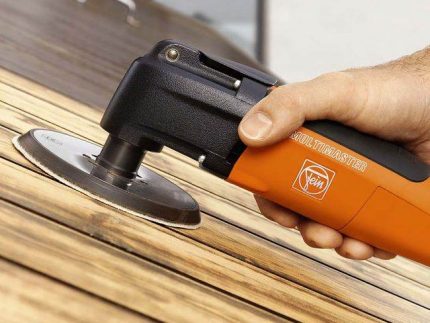
Sometimes the focus development process takes place secretly: a few subtle stains appear on the upper part, but active destruction occurs inside. “Sick” cladding or logging details can be recognized by a thud. A solid-looking timber, affected by rot, breaks when pressed.
Mold is harmful not only to the wood itself, but also to people who inhale air contaminated with spores. If there are allergies in the house, if there are foci, they will always feel unwell. Small fungi are also dangerous for healthy people - they can provoke the onset or exacerbation of various diseases of the respiratory system.
The most vulnerable and susceptible to mold in a wooden house is bathroom or a combined bathroom. The shower room suffers in the same way, even if the box is impeccably sealed and does not let a drop of water pass.
Therefore, when arranging hygienic rooms in buildings made of timber or logs, it is mandatory to comply with the technology of their organization and apply protective antiseptic agents.
Causes of wood destruction
Suppose that the inside of the house was lined with completely healthy boards. Nevertheless, over time, they also began to turn blue and gradually become covered by ugly stains. What does this come from?
Mold is propagated by spores that are present absolutely everywhere - in the forest, in the fields, on the roads. It is estimated that species that live in forests and live on living trees cover about 40% of the surface of trunks and branches of these trees and shrubs. They do not destroy the bark and other tissues, but make them more porous.
Spores are easily tolerated by wind, animals, and even shoes. If microorganisms by any of the listed methods get into the house, where favorable conditions are created for them, they quickly begin to multiply. Ideal conditions for the existence of mold is increased humidity (from 70%) and temperature from + 5ºС to + 30ºС.
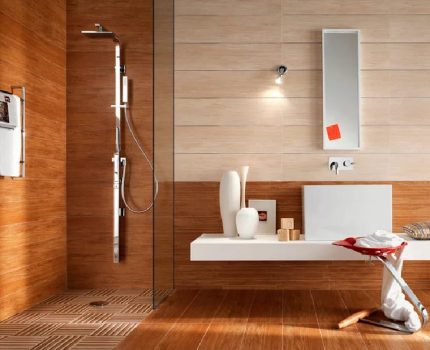
Wood is only one of the materials on which whole colonies of fungi settle. They can sprout on rubble stone, concrete, plaster, paper and even plastic.
The owners of seasonal summer cottages in central Russia are well aware: if you do not regularly heat a wooden house or follow basement condition and foundation, then in the corners, on the ceiling and even on the furniture dark spots are sure to appear.
The same trouble threatens cellars and wooden baths if ventilation is not organized in them. Even the inner lining of the clapboard can become infected with a fungus and become completely unusable if it does not have the ability to ventilate and dry out.
The lack of air circulation also favors the rapid proliferation of moldy colonies. This can be seen in urban apartments, where the bathrooms are lined with wooden panels and ventilation is impaired.
If the surface of the panels is not treated protective compound, they will soon be covered with a light white or black coating, and over time, the lining will become neglected.

Thus, the cause of the appearance of fungus or mold is the lack of waterproofing, ventilation malfunctionshigh humidity.
Do-it-yourself solutions
If the reasons for the appearance of mold are not eliminated, even after its complete destruction, spores can enter the room and return the problem. Therefore, it is necessary to carry out a number of measures to eliminate favorable conditions for the growth of the fungus, the most common of which is high humidity.
First steps to be taken:
- if it is damp in the attic or in the basement, it is necessary to think over hydro and vapor barrier, check the integrity of the roof and the condition of the foundation;
- in case of air circulation disturbances, establish ventilation or design a new, more efficient system, install forced air supply devices (fans);
- if conditions allow, to ensure the penetration of sunlight (relevant for verandas, terraces, balconies) - mold does not tolerate ultraviolet radiation;
- in the process of repair, along with wood paneling, it is imperative to use a vapor barrier membrane to protect against condensation;
- check the condition of surfaces bordering the infected area;
- thoroughly warm and dry the room where new mold colonies periodically appear - a heat gun is suitable for this.
If summarized, then you need to carry out any possible measures that reduce humidity.
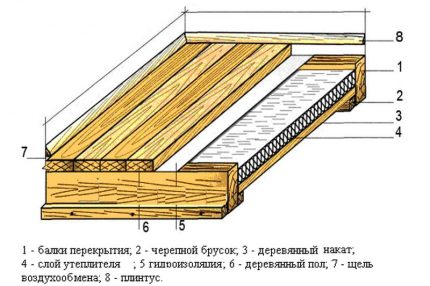
Consider how to get rid of mold on logs or boards using chemicals.
There are a number of solutions that can be purchased at an hardware or hardware store:
- Dali - suitable for concrete, tile, wood, painted surfaces;
- Biotol Spray - used for processing facades, cellars, attics;
- Alpa - antifungal agent for interior work;
- Stop Mold - a concentrated composition for treating the areas most vulnerable to infection - basements, terraces, attics, greenhouses.
To apply the tool, you must remove visible mold, rinse the areas with clean water, after complete drying, apply an antiseptic solution in several layers.
You can get rid of a mold spot in a simple, but time-consuming way:
Folk methods of getting rid of the fungus
When using funds that are commonly called folk, you need to remember three points:
- their application is often remembered when it is too late and more effective solutions are needed;
- it is difficult to remove overgrown foci with household solutions, and when they are destroyed, there is always a risk of the appearance of new colonies;
- getting rid of mold, you must simultaneously eliminate the causes that gave rise to it.
Consider the available funds that you can find at home or buy.
Chlorine bleach
In stores, a solution is sold, which is traditionally called "White." The compositions of different manufacturers may vary, but the main substance does not change - it is sodium hypochloride, a powerful antiseptic and oxidizing agent.
At chemical plants, water and various surfaces are disinfected with it; in everyday life, bleach fabrics and sanitize bathrooms.
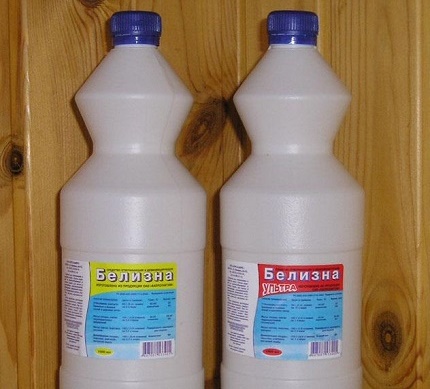
During use of the solution, it is important to determine its concentration. Usually, “Whiteness” is diluted with water in a ratio of 1:10, but a more powerful antiseptic is needed to combat mold, so the proportions change by 1: 1.
Whiteness is ideal for smooth surfaces such as tile or hard plastic. Wood has a porous texture, which is very difficult to process, therefore, chlorine solution is suitable only for removing external signs, stains and stains, it will not save from the deep penetration of the fungus.
The concentrated composition is applied in several layers with a paint brush, then washed off with clean water. If the focus is in an inaccessible place (in the attic), the product can not be washed off.
Pharmacy antiseptic solutions
Hydrogen peroxide, which treats wounds and scratches, copes well with the fungus. As a rule, a small bubble of peroxide can always be found in a medicine cabinet, so that nothing prevents a small experiment.
Moisten a cotton pad with a few drops of the solution and wipe the wooden surface affected by the mold. If the stains disappear, you can process a clean area several more times.
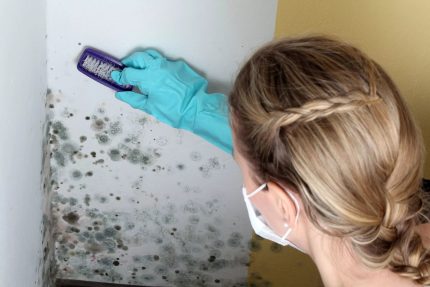
If you purchased a bottle with a 3% solution, do not dilute it with water, this concentration is not considered strong. It is enough to apply peroxide to the damaged area and leave for a while, then repeat the procedure.
The second solution "from the pharmacy" is ammonia, which is part of the means for washing windows and washing the print heads of inkjet printers. It also acts effectively on smooth surfaces (glass, earthenware, plastic), and with moderate success - on wooden (or plasterboard).
The procedure should be carried out according to the same rules as with "White": diluted in a 1: 1 ratio, do not forget to wear gloves and a respirator.
The use of "kitchen" tools
At least two products that are used to combat mold can be found in the kitchen cabinet. This is vinegar and soda.
Vinegar, like "Whiteness", is not able to completely remove the foci of mold, but, unlike it, it is absolutely safe for humans. It is not diluted with water, but in a large volume is applied to infected places with a roller, brush or sponge.
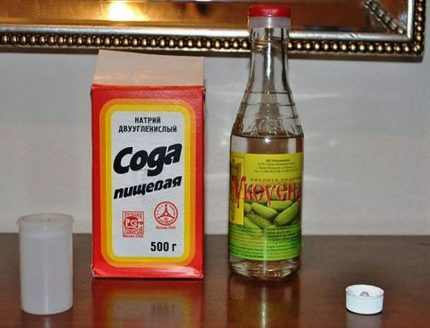
If the mold area on a wooden surface resembles plaque, then there is a chance of completely getting rid of it. However, do not forget about the survivability of harmful microorganisms and wipe areas at risk every 2 weeks - until you fix the ventilation and insulate the room.
Soda is also one of the safest means. It is often used for cleaning children's things, washing dishes. However, paired with vinegar, it can destroy a small colony of mold. If you notice a scattering of small black dots on the walls, dilute soda in vinegar and wipe the infected area.
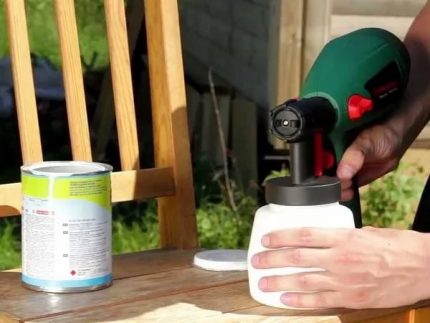
Soda does not harm wood, so this option is also possible: pour a small amount of powder onto a slightly moistened cloth and rub into a damaged place, and then rinse with water.
Antiseptic Product Market Overview
When folk remedies are useless, heavy artillery enters the battle - highly effective chemical solutions, which are used both for prophylaxis (initial treatment) and for the “treatment” of already damaged elements. Consider the popular antiseptics that can be found on the shelves of building supermarkets.
Most of the funds presented by modern manufacturers are versatile. Their composition is such that it simultaneously protects the wood from rot, mold, sunlight, bugs and even fire.
The wood for the exterior cladding of the house, like all elements of the decorative interior design, should be processed without fail, otherwise the risk of damage is very high.
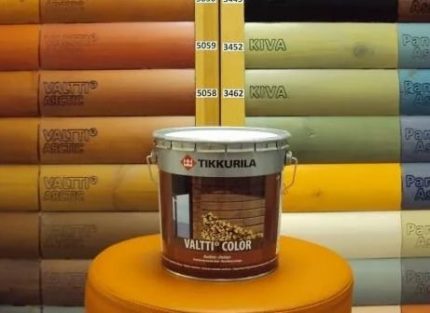
We will name several manufacturers of antiseptics that are popular and with enviable regularity occupy the top lines of ratings:
- Tikkurila. Known for a large assortment of multicomponent impregnations that can protect wood in the most difficult conditions. Pay attention to Valtti Pohjuste deep penetration primer, Vinha coating solution. Valtti Color tint azure impregnation (Extra, Satin, Primer series) penetrates deep into the wood fibers and does not form a film, as a result of which wooden products look natural.
- Senezh. The most reliable is an antiseptic for deep impregnation, ideal for processing facades. It is not washed out by water and is able to protect wood in difficult weather conditions. Senezh Ecobio is designed for use inside the house, and Aquadecor is created specifically for decorative design. A lot of positive reviews about Senezh protective products for saunas and baths.
- Belinka. Suitable for processing internal and external wooden surfaces. BELINKA BASE contains a concentrated portion of biocides, BELOCID is suitable for both prophylaxis and treatment of infected surfaces. BELINKA IMPREGNANT - colorless impregnation, good where it is important to preserve the natural texture of the fibers.
- Aquatex. Perfectly protects logs, boards, lining, chipboard from mold and wood-bugs. It has more than 10 tinted options. The solution is used as a primer or impregnation.
- Neomid. Well-known Russian brand with a wide line of antiseptic agents. NEOMID 440 ECO effectively protects wood products in rooms with high humidity, NEOMID 400 is used for processing interior parts, NEOMID 46 BiO protects lumber from mold damage.
The list can be continued with the names of alternative products: Dufa Wood Protect, Sayteks, Pinoteks, Texturol, Woodmaster. Using this or that means, it is necessary to act strictly according to the instructions.
Professional mold control
There is another effective method of removing an unpleasant “guest” - calling specialists.
They may be something that the residents of the house themselves will not be able to:
- conduct microclimate diagnostics using high-precision instruments;
- analyze the condition of the affected objects;
- will conduct an examination and draw up a conclusion on the nature of the occurrence of foci of mold on wooden surfaces;
- they will select the most effective professional means and treat the fungal growth sites with biocides;
- will neutralize the air in the premises of the u / f installations.
If necessary, professionals will carry out construction work: increase ventilation efficiency, reduce heat loss by laying insulation, restore normal humidity by installing waterproofing.
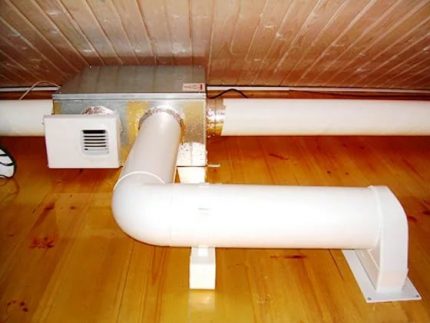
The main advantage of professional processing of the premises is the guarantee that mold will not be disturbed in the near future.The most responsible companies undertake obligations to carry out repeated measures to eliminate newly emerged foci.
If you decide to call a team of specialists, take care of documenting the order. The service agreement must include a warranty period and a list of procedures performed. If workers carry out construction activities, then they must be guided by the requirements of GOST and SanPiN.
Conclusions and useful video on the topic
Informative videos will help you choose a tool to protect wood from mold and teach how to use it.
Clip # 1. Valuable tips for choosing antiseptics:
Clip # 2. Application instructions from düfa professionals:
Protection of wooden boards, logs or facing elements from mold can be done by yourself, but taking into account the recommendations of the manufacturer of special tools and compliance with safety standards.
If you choose the right impregnation or decorative protection, the wood surface will retain its original appearance for a long time, and well-made insulation and effective ventilation will create conditions under which mold will never settle in your house.
Do you know an effective way to get rid of mold in addition to those that were given by us? Do you want to share your own experience in the fight against this very persistent biological phenomenon or want to ask a question? Please comment in the box below.

 Antifungal agent for walls: a comparative overview of the best options
Antifungal agent for walls: a comparative overview of the best options 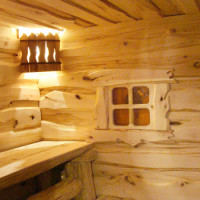 Ventilation in the bath: an overview of traditional schemes and nuances of arrangement
Ventilation in the bath: an overview of traditional schemes and nuances of arrangement 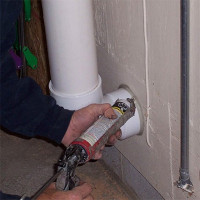 DIY ventilation in the apartment: an overview of the nuances of arranging the ventilation system
DIY ventilation in the apartment: an overview of the nuances of arranging the ventilation system 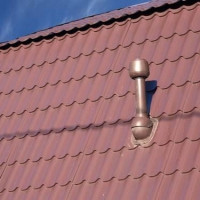 Roof ventilation for metal: an overview of options and nuances of arrangement
Roof ventilation for metal: an overview of options and nuances of arrangement 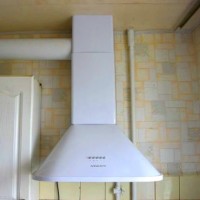 How to install the hood if the gas pipe interferes: briefing on the work
How to install the hood if the gas pipe interferes: briefing on the work 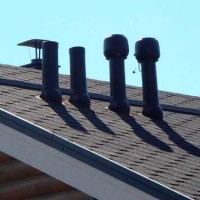 Adjoining the roof to the ventilation shaft: arrangement of the passage of the ventilation unit through the roof
Adjoining the roof to the ventilation shaft: arrangement of the passage of the ventilation unit through the roof  How much does it cost to connect gas to a private house: the price of organizing gas supply
How much does it cost to connect gas to a private house: the price of organizing gas supply  The best washing machines with dryer: model rating and customer tips
The best washing machines with dryer: model rating and customer tips  What is the color temperature of light and the nuances of choosing the temperature of the lamps to suit your needs
What is the color temperature of light and the nuances of choosing the temperature of the lamps to suit your needs  Replacement of a geyser in an apartment: replacement paperwork + basic norms and requirements
Replacement of a geyser in an apartment: replacement paperwork + basic norms and requirements
This misfortune also did not pass us by. And with what exactly I agree, it is with a ventilation device. We did so, and mold began to spread much more slowly. But the choice of funds took a long time. All folk methods did not help (they tried vinegar, peroxide, etc. substances). Once I bought a product not for wood, but for a bath. It smelled mercilessly, but, oddly enough, it helped. I had to do the treatment 2 times, already pinching my eyes. The mold washed off in some places. After they did the treatment with a preparation for wood. And, pah-pah-pah, mold has not been felt for six months now.
Three years ago, a fungus started under the floor in the house, either flood water leaked, or because of the general high humidity. The first thing, of course, was ventilation in the foundation. He just opened the pipes from both sides, and so that the animals did not penetrate the house, he closed the holes with a grid. I treated the affected areas with a varnish, after 5 days I again treated it with a solution of soda and salt with boric acid (diluted by eye). It seems so far so good.
We have a wooden house under construction 60 square meters. m. Faced such a problem: traces of mold appeared on the beams and walls. We treated the infection sites with a simple method - whiteness. After almost half an hour, the tree turned white and became clean. On the ceiling, the infection was more serious, the first time it was not possible to remove unpleasant traces, it took several times to get around. The main whiteness to buy in such old Soviet packaging. Wood bleaches are more expensive in stores, and most have a similar composition to whiteness.